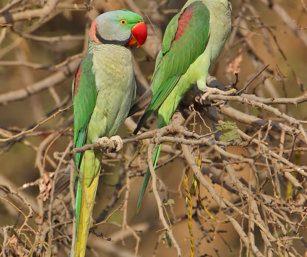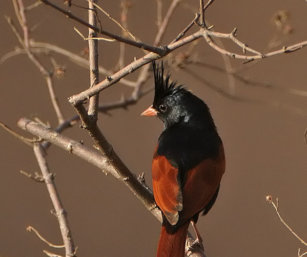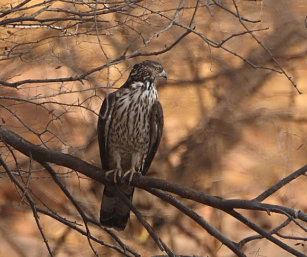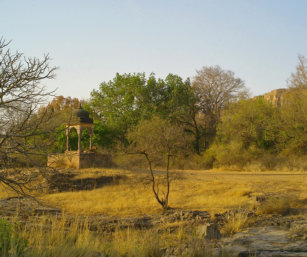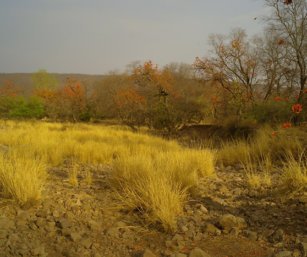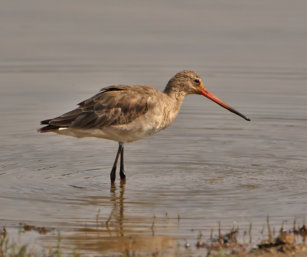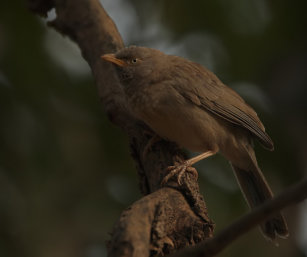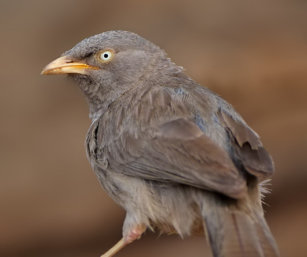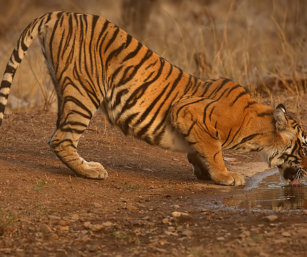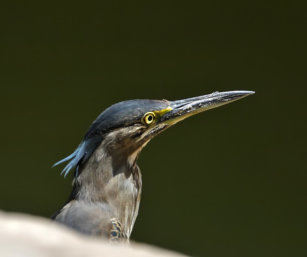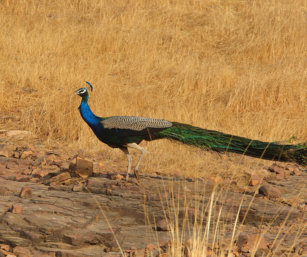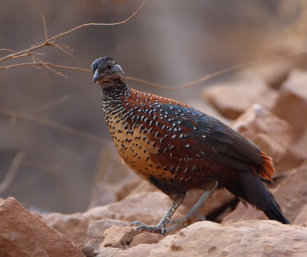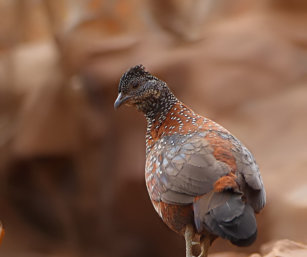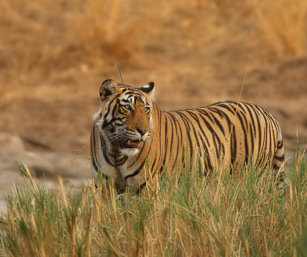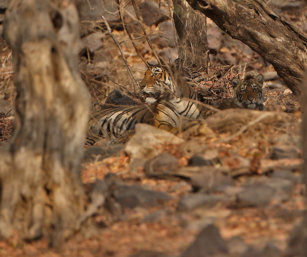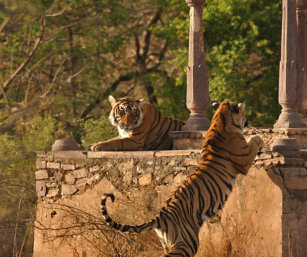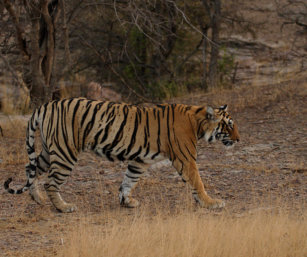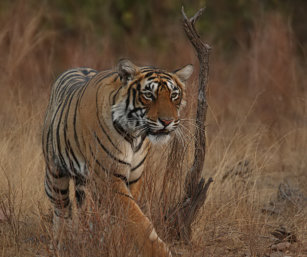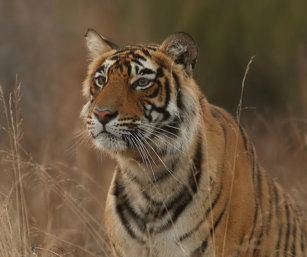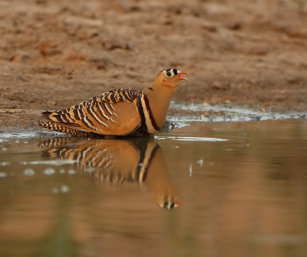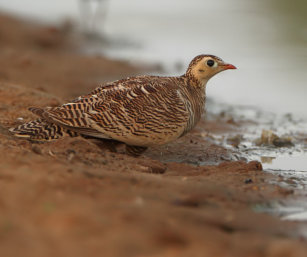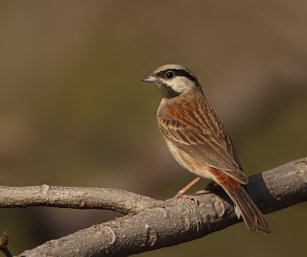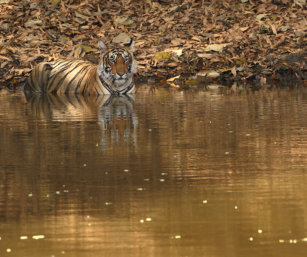Ranthambore, April 2008
Nine tigers and other animals!
Once in a while the tiger bug infects us and it is time to leave the verdant jungles of South India for the drier climes of the Vindhyas or the Aravallis. This time the bug took us to Ranthambore in Rajasthan, at the exact intersection of the two ranges, thanks to the persuasion of the Sarathys – good friends and tiger enthusiasts.

Since it was early April, and the usual chaotic financial closing time, the entire planning and the travel to Ranthambore was a blur and only the first drive into the fantastic park awoke us to the reality! Our first two drives in the famed Ranthambore National Park yielded no tigers. Not even a trace. We were beginning to worry about our luck and my earlier stint with the park. A few years ago, my first trip to Ranthambore, even after five full days in the park, we came back without a sighting. One pugmark to console us all and tempt us to come back. This time around, tigers were what we had come for and tigers we had to see.
The dry deciduous jungle and its cats beckoned us and we did not want to give up on our luck that easily. The spectacular and famous Ranthambore fort provides the backdrop to all action in the park and the huge vertical cliffs on either side look down ominously as one begins the climb toward the fort. White-backed and Long-billed vultures nest here though we weren’t lucky in seeing them. At the base of the fort parakeets (three varieties), treepies, petronias and pigeons were all there to provide a rackety welcome. The langurs added serious entertainment too – drinking water off a tap and playing hide-n-seek inside empty jeeps.
As we drove on onto the park, we found Padam talab with a fair number of birds. the new ones for us were the Black-tailed godwits and Common snipes. However, the focus was tigers. Like our guide, Hemraj Meena told us in quite a tough tone, “Madam, you want to see tigers or birds? You can’t see both. Inside the park it is only tiger. You want to see birds; I’ll take you outside… lots of birds there”. It was almost like bringing us back to our senses. Hemraj (and every other guide / driver in Ranthambore) could not quite understand why we wanted to spot birds in a tiger country! It’s tough for a birder inside Ranthambore! Ranthambore lies at the edge of a plateau, and is bounded to the north by the Banas River and to the south by the Chambal River.
The tourism zone has a high density of tiger population and is divided into five zones. Each zone is large and provides ample opportunity to spot tigers and also experience the various facets of the park – grassland, cliffs, waterholes, dense sal forest, streams and lakes. We weren’t aware till end of day one that it was zone 3 that was buzzing with tigers! A tigress (Machili’s daughter) with her three fully grown cubs were spotted everyday in this zone. And as allotment of zones to each vehicle is done by draw, one had no choice but to accept the zone that was drawn. What we weren’t also aware of was that our friend Srikanth Sarathy had a very lucky hand! On the morning of the second day he picked the draw for us and out came No.3! We knew the day would be a wonderful one for us, after all we had left the hotel at 5:00 am and rushed to the park entrance to be the first ones to get inside.
And the early bird does get its worm! No sooner than we entered our zone, we spotted one of the cubs walking without a care along a small stream. As he crossed the stream, we noticed another cub right across sitting in the grass up a small hill. As both came closer we could sense some communication among the two. Just as we thought that they would lie on the grass again, we found both get up and walk down the hill. As their pace quickened, we saw the third cub joining in from the left. We wondered about the sudden heightened activity. Then we found the reason – a herd of chital at the foothill. The three cubs were trying to ambush them from different directions.
We had thought that only lions hunt in prides! The early morning sun glazed over the three ochre bodies making them larger-than-life and and fiery. With the backdrop of the deer, tall grass and the cocked ears of the cubs, the scene was very serene yet exciting with the imminent potential drama. We were sure they would kill. But, the deer were alert and fast. They immediately detected the tigers’ presence and started calling from a safe distance. The hunt was over and the cubs gave up in their half-hearted attempt and decided to rest in traditional chattri (an umbrella like structure – a remnant of the fort) nearby. Some of our best tiger images were made on this morning drive. We were extremely content and even ready to get back to Bangalore.
But as luck would have in store for us, we were to see six more tigers in the next four drives! The evening drive was memorable and got us face to face with a tigress on a kill. She had hunted it just before we reached the spot. We saw her come out of a nearby waterhole cooling off after the hunt. She was panting desperately – it must have been hard work killing the adult sambhar in the hot sun. She was less than 20 feet from us as she stayed guarding her kill from crows. When the crows got her irritated she decided to pull the carcass to a sheltered area. But, first she had to decrease the weight of her burden. She decided to eat some of the kill. She ripped open the intestinal area of the sambhar and slurped the organs – small intestine, the large intestine, the stomach and all.
We hadn’t seen such gore before. But, National Geographic and Animal Planet do prepare you well to take these scenes bravely! After she had her fill she dragged the animal across the road to the shade. We waited for her to signal to her cubs. Her cubs we heard from our guide, Devendar, were much smaller and hadn’t been seen out in the open. We left her with her treasure hoping to see the cubs some other time. And the some other time was the evening of the next day. We managed to spot her with two tiny cubs, not more than a few months old. The mother had just stepped out soaking wet from a algae covered pool appearing with a ‘green coat’. The two cubs were playing with each other with gay abandon. It was truly an endearing sight and we wished the evening would never end.
That morning, saw us going onto zone 3 (Srikanth’s hand again!) and this time we saw the three grown up cubs cooling off in a waterhole. As we watched them, we realized there was a fourth one close-by. It was their mom! She was watching a kill under the shade of a tree beside the waterhole. While we couldn’t see her, we caught a glimpse of her in the reflection of the water. As we watched the family, we saw them take turns in eating the kill and cooling off. What a life they had – kill, eat, rest; kill, eat… The next morning, we decided to visit the not-so-famaous Sawai Mansingh Wildlife Santuary about 20 km from our Sawai Madhopur hotel. With an early start and the news that hyenas were spotted frequently in Mansigh we decided to give our tiger luck a break.
Mansingh Santuary is dry decidous like Ranthambore with very steep rocky crags and outcrops. Our driver took us atop a hill from where the view of the entire land below was astounding. The morning sun rose over our shoulders and down below were a pair of Nilgai bulls with their horns locked in a fight. The driver then pointed to another hillock across and said that was were the hyena’s den was. We couldn’t spot the hyenas and climbed close to the hyena’s den to take a peek. An awful stench hit our noses, bones and hide were strewn all around the cave’s entrance. Apparently the hyena had little cubs and of course they were to be fed. Though we couldn’t spot the hyena family we were glad that they were safe under the able protection of the local forest department.
That evening we didn’t have too much expectation from our last drive into Ranthambore National Park. But, our lucky streak had not still left us and we were gifted with the sight of the huge male, radio-collared T10, walking ever so majestically along the stream, cross it, then strutting on the jeep trail just a few feet ahead of us, as dusk settled in Ranthambore. He was the only adult male we saw and he was truly the hero of Ranthambore. With our time in Ranthambore coming to an end, we had to ice the cake with one of our key targets – the Painted Sand grouse. Devender dashed us off to a nearby place outside the park at sundown where the birds come for an evening pre-roosting drink. We were racing against time as the Sarathys had a train to catch as well as the rapidly setting sun. Luck came to our help again and we were able to get great views of this beauty.
During our stay we were also lucky to meet Gobind Sagar Bharadwaj, the former park director of Ranthambore. His tryst with tigers started with him being mauled during his very first sighting of the big cat. “The tiger could have killed me. But he was gentleman. He gave me a warning and left,” recounted Gobind who spent close to month in hospital to recover from the deep maulings. His narration sent a chill down our spines, but our respect for the striped cat grew enormously like it did for Gobind after the attack. Gobind’s fantastic coffee table book – Tracking Tigers in Ranthambore – recounts his three years as official protector of Ranthambore tigers and also as an ardent tiger lover. Interspersed with great tiger images this book is a must read for all wildlife enthusiasts.
Overall, Ranthambore is a treat for wildlife enthusiasts offering the “African Safari” in our own land with tiger viewing opportunities at close quarters. An oasis for tigers in India, and the world, Ranthambore is a conservation success thanks to better management and protection from both state and central governments. Last month forestry officials claimed fourteen tiger cubs to have been spotted in Ranthambore. These sightings are a rare piece of good news in the fight to halt the steep decline in tiger numbers in India. With reports of tigers wiped out in nearby Sariska in 2005 pressure remains on Ranthambore as the only safe tiger haven in Rajasthan.
–Swarna, Bangalore | May 2008






